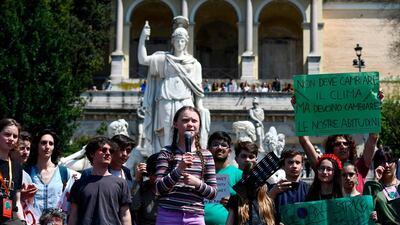Like the issue on which she campaigns, climate activist Greta Thunberg is a global phenomenon.
The Swedish teenager behind the international school protests on climate change now has the ear of world leaders, and is not holding back.
Her message is simple: the science is in, catastrophe looms, and her generation wants action - now.
Thunberg, 16, admits her demand that politicians listen to scientists isn’t new. “I’m just speaking on behalf of them”, she told the BBC last week.
“I’m trying to say what they have been saying for decades”.
Cue the standard rejoinder: that the science isn’t settled. Didn’t climate experts fail to predict the pause in global warming between 1998 and 2012?
Haven’t they admitted it’s wrong to blame every devastating flood, forest fire and hurricane on climate change ?
Ironically, the fact that there are gaps in climate science is the strongest reason for taking seriously Thunberg’s demand for immediate action.
That’s because the biggest gaps surround the risk of the climate suddenly changing into a disastrous new state.
It’s a possibility that even many climate scientists have arguably not taken seriously enough. They have long accepted that the climate is an incredibly complex “non-linear” system, with small changes not necessarily having small consequences.
In the case of climate change, that means global temperatures no longer rising at around a degree or so a century, but suddenly lurching up to disastrous levels.
This is not some theoretical possibility. Analysis of ice cores from Greenland suggest the last Ice Age ended around 12,000 years ago when temperatures soared by 10 degrees in just a few years.
The driving-force of such dramatic events are so-called positive feedback loops, where warming triggers events leading to even more warming.
For example, as glaciers and polar ice-caps melt, they reflect less of the sun’s radiation back into space. This accelerates the melting rate, triggering more heating, yet more melting – and a potential hike in sea-level.

Increasing global temperatures also raise the spectre of vast quantities of natural greenhouse gases being released into the atmosphere.
So far most concern has focused on the methane currently trapped in the world’s permafrost regions.
Released when the organic material thaws and rots, methane is over 30 times more potent a greenhouse gas than CO2. Yet the science of how melting permafrost might affect global temperatures is far from settled.
So far, nearly all impact assessments have assumed simple “linear” effects, where small increases in temperature produce small changes in the release of both CO2 and methane.
But now researchers are using more sophisticated models that include non-linear effects – such as the impact of reduced snow-cover, and thus decreased heat reflection.
Early indications suggest the old models seriously underestimated the threat. Until now, the melting of permafrost has been seen as a feedback loop that will only emerge when global temperatures are well above those predicted for the coming century.
But research published last week in scientific journal Nature Communications suggests even current plans to keep global temperature rises less than 2 degrees above pre-industrial levels may not prevent serious impacts.
While climate scientists grapple with the implications, yet more evidence of the gaps in their knowledge has emerged - this time concerning a greenhouse gas ten times more potent than methane.
More commonly known as laughing gas, nitrous oxide or N2O is hard to detect in the atmosphere, and thus routinely ignored in global warming models.
But now a team led by researchers at Harvard University has published the first measurements of N2O over thawing permafrost in Alaska. They are 12 times higher than anyone expected.
The researchers admit to being shocked by their findings, which appear this month in another journal, Atmospheric Chemistry and Physics.
"We didn't know it was significant at all", said team leader Jordan Wilkerson. “This needs to be taken more seriously than it is right now”.
Yet potentially the biggest joker in the climate pack lies above and below the world’s seas.
Scientists have identified complex patterns of oceanic and atmospheric behaviour linked to chaotic weather. The best-known is the so-called El Nino effect, in which a vast region of the central Pacific periodically warms up, causing dramatic storms as far away as India.
Other such patterns have been found in the atmosphere, such as the North Atlantic Oscillation (NAO), which affects winter weather over Europe.
Caused by non-linear effects, the appearance of these patterns is hard to predict: El Nino takes place at anything from three to eight year intervals.
But every so often, they all come into sync, with consequences for the entire planet.
Sometimes they boost global temperatures and sometimes they reduce them. According to some researchers, they played a key role in the apparent “pause” in global warming earlier this century.
But it’s also possible that as global warming increases, these effects could conspire to tip the climate into some disastrous new state. Again, the science is far from settled.
Sceptics typically seize on such gaps in knowledge to cast doubt on the whole issue of global warming. Thunberg may be wrong about the omniscience of scientists, but the risk of sudden climatic makes her plea for action compelling.
Robert Matthews is Visiting Professor of Science at Aston University, Birmingham, UK

